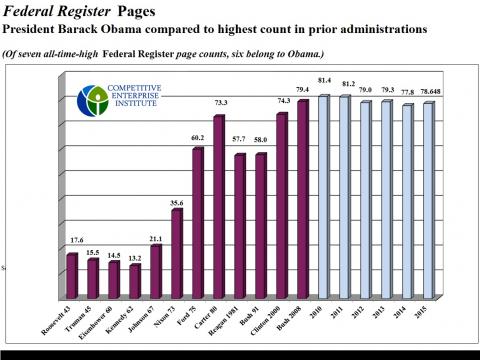For those of us worried (with good reason!) about excessive regulation and red tape, 2015 was not a good year.
As you can see from the headline of this story in the Washington Examiner, ![]() federal bureaucrats were very busy imposing new mandates and restrictions on the economy. Indeed, President Obama now has the cumulative record for red tape.
federal bureaucrats were very busy imposing new mandates and restrictions on the economy. Indeed, President Obama now has the cumulative record for red tape.
That’s obviously good news for compliance bureaucrats, lawyers, and others who get fat and happy because of the regulatory state. But it can’t be good for growth and competitiveness to have all that sand thrown into the gears of the economy.
And to put the numbers in context, here’s a chart from the folks at the Competitive Enterprise Institute. On the left side, it shows the biggest red-tape year for every President before Obama. And then on the right side, it shows how Obama is consistently meeting or exceeding prior records.

All this bad news might be somewhat bearable if there was some reason to think we were turning a corner and that the worst was behind us.
Unfortunately, that’s not the case. Let’s now share another headline, this time from a report in The Hill.
![]() The bottom line is that the Obama Administration is openly excited about the prospect of building upon the President’s dubious red-tape record.
The bottom line is that the Obama Administration is openly excited about the prospect of building upon the President’s dubious red-tape record.
Though I guess we shouldn’t be surprised. If you read the story, you’ll see that next year will be a perfect storm of pro-regulation bureaucrats being egged on by Obama’s regulatory appointees who see 2016 as their last chance to impose additional red tape on the economy’s productive sector.
But the private sector will become less dynamic as we become more like Greece. Here are some very depressing bits of information I’ve shared in the past.
- Americans spend 8.8 billion hours every year filling out government forms.
- The economy-wide cost of regulation is now $1.75 trillion.
- For every bureaucrat at a regulatory agency, 100 jobs are destroyed in the economy’s productive sector.
- A World Bank study determined that moving from heavy regulation to light regulation “can increase a country’s average annual GDP per capita growth by 2.3 percentage points.”

